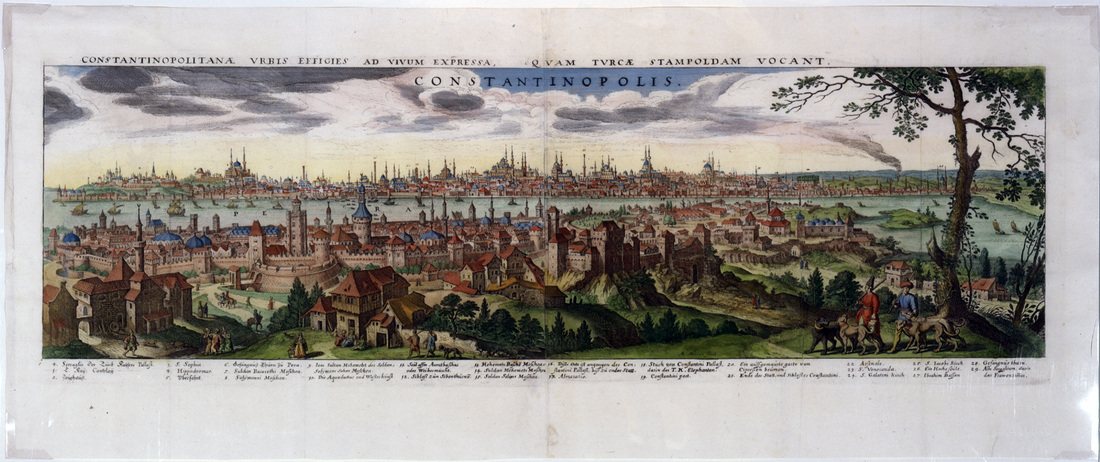 View of Constantinople for Pera, 17th century. Since I wrote last, I have spent some time in Constantinople and I feel that I must tell you about it! There are so many people here in Pera, and so many who write about Constantinople who have never even seen the city, staying only in Pera, Tophana, and Galata, the Frank Christians areas, even though it is only separated by a sea not half as wide as the Thames at its widest. And yet the won't go.
The women would have to cover their faces, which they are averse to, and while, they do wear veils in Pera, it is only to accentuate their beauty. I think the French Ambassadors will leave without ever even seeing it. I have gone there many times int this journey, they veil has become easy and agreeable to me, and even if it wasn't, it's worth a little inconvenience for the experience. The city sits on the European side, situated on seven hills and with the perfect mixture of gardens, pine and cypress trees, palaces, mosques, and public buildings, raised up above each other. The symmetry of it all makes me think of a perfectly organized cabinet. I have seen the Seraglio, an enormous but slightly irregular palace, and St. Sophia, which was extremely difficult to seem [1]. I had to send my request to the Caimaicam, the governor, three times, and then he met with the chief effendis, and then asked the mufti whether it was ok, before I was finally given permission. I'm not sure why the Turks are so much more delicate on this subject than Christians, but I can only imagine that, because the structure was once a Christian Church, they fear that people might profane it with their prayers, especially to the saints as their images still appear in the mosaics in the building (contrary to what some other writers have said, the images were NOT defaced by the Turks). The dome at the top of the building is said to be 113 feet in diameter and is held up by 2 pillars of solid marble. I also saw the grave of Emperor Constantine, which was great revered by my guides.
I think I enjoyed seeing the Turkish mosques better though. The Sultan Soliman's is one of my favorites. The mosque and grounds are perfectly square with four large towers and the large cupola is supported by beautiful marble pillars. Under the great cupola is a fountain covered with colored pillars. On one side is the pulpit, which is made of white marble, and on the other, there is a little gallery for the Grand Signor. At the upper end is a sort of altar and the mosque lit by a large number of lamps. Many of the mosques in the area of very similar in their layout. I also saw Validé's, the first mosque built by a woman and seriously the most beautiful structure I've ever seen! Between us, I think St. Paul's would look pretty pitiful next this: 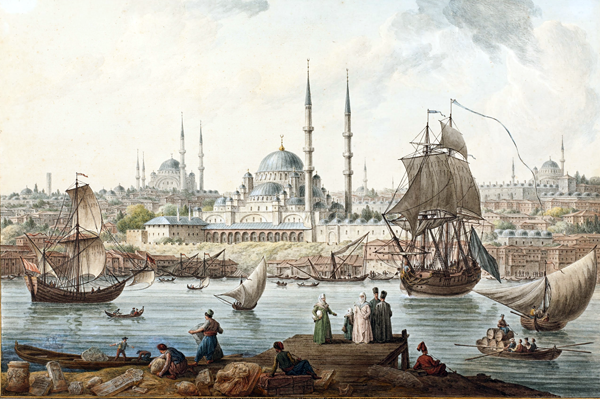 Yeni Camii and The Port of İstanbul by Jean-Baptiste Hilair. Late 18th Century Just as any of squares would next to Alterdan, or the place of the horses, the Hippodrome in Ancient Greek times. There is a large column with three twisting snakes and the obelisk brought from Egypt in this square. Really there's not much else worth seeing besides Sancta Sophia. Although Sultan Achmet's mosque is also nice with its brass gates! 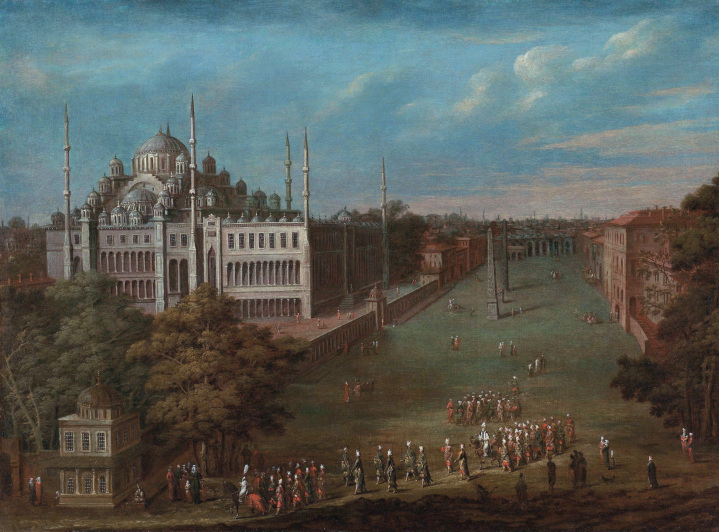 The Grand Vizier is crossing the Atmeydan Square, Jean Baptiste Vanmour The exchanges are all very noble looking buildings, full the alleys, each one dedicated to a different trade. It's pretty similar to the New Exchange at London. The Bisisten, or jewelers quarters, is full of extraordinary diamonds and precious stones! Now, I know you expect me to discuss slavery, but the Turks seem to treat them very humanely and is, in my opinion, no worse than servitude all over the world. True, they aren't paid, but what they are given yearly in clothes amounts to more than a regular servant makes in England. Now I know you're thinking that men will buy women with bad intentions, but, again in my opinion, this seems to be done as publicly and more infamously in our Christian cities [1]. The only pieces from antiquity I have seen are the aqueducts, which might even be older than the Greek Empire! The other public buildings are mostly hans and monasteries, of which I saw one. The men there are permitted to marry, but only wear a coarse white cloth wrapped around them for clothes. The order doesn't seem to have too many rules beyond performing rites on Tuesday and Friday, during which they meet in a large hall, starring at the ground with their arms folded while the Imam or preacher reads from the Alcoran. When this is over, a number of them play music, which is then followed by a short speech on what was read. Finally, they sing and play until someone begins a dance that lasts about an hour. It is all done very seriously and they seem devoted to their contemplation. As weird as this might sound, there was something very touching about their air of submission and the level of seriousness.Sorry for going on so long! More soon!
 Mustafa II, 1695-1703 the Ottoman Sultan Mustafa II, 1695-1703 the Ottoman Sultan Welcome Mary Wortley Montagu, born January 19, 1718! I have to say, giving birth wasn’t half as mortifying here as it is in England. No one bothers laying in for an entire month and I was up and visiting friends again in three weeks time!
Just a few days ago, I went to visit Sultana Hafise, the favorite kadin of the last Emperor, Mustapha, who was deposed by his brother and died shortly after (they think he was poisoned!). The Sultan then forced her to marry, even though she begged him not to make her as she had vowed she would never sleep with another man. To prove her point, when she was forced to choose, she picked the secretary of state who was over 80 years old. Beyond his age, she chose him because he was the one who brought her to the former emperor. She is still in mourning today and could not talk about him without tearing up...
She was quite beautiful, though not nearly as beautiful as Fatima. It was her dress was what really stood out. She wore a vest called a dualma, which has longer sleeves than the caftan. It was purple and lined with pearls, with large gold loops as buttons. The whole things was tied with two large tassels of smaller pearl and the arms were lined with diamonds. She had three long necklaces on, one of pearl with a an emerald as big as a turkey egg! Her earrings eclipsed everything else though—two pear shaped diamonds the size of hazelnuts. She had four strings of pearls each as large as the Duchess of Marlborough’s! And her rings were the largest diamond rings I’ve ever seen (except for Mr.Pitt’s of course).
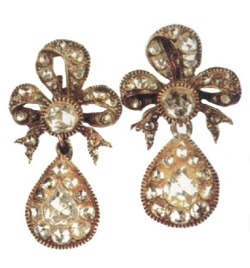 Not quite as nice as the Sultana's Not quite as nice as the Sultana's
but you get the idea! We had a beautiful dinner, and the display on the table was equally as lovely as her dress. The napkins were so nice; I didn’t even want to wipe my hands on them! After dinner, we had coffee in gold soucoupes. Her home was equally as richly decorated as the table. Even her servants were dressed in gold.
Now I know you’re going to say that this sounds made up, like I copied right out of the Arabian tales, but this is what I actually saw! We travel bloggers have a hard time, we we only say what’s been said before we’re boring, but if we say anything new, suddenly we’re exaggerating and romanticizing what we see, so much so that should I come home, I won’t even discuss what I’ve seen with anyone.
I went to see Fatima yesterday as well, and if you don’t believe my descriptions above, you’ll never believe what I’ve seen in her palace! The Sultana was nice, but the grace and manners of court come so naturally to Fatima, she immediately inspires respect and tenderness and now that I am learning her language and can talk to her, I find her wit equally as charming! The servant I had with me couldn’t believe she was a Turkish Lady and thought she must be a Christian (and as it turns out, her mother is). I had to tell her what a stir her beauty would cause in London! And she, in her infinite sweetness, replied that if England valued beauty as much as I say they'ed never have let me leave!
This blog is getting way too long, so I’ll stop here before a turn into a downright storyteller. It may be a proverb that knowledge is no burden, but knowing too much will still most likely make us troublesome to other people…
 Gold encrusted with diamonds, composte service, Topkapi Museum.
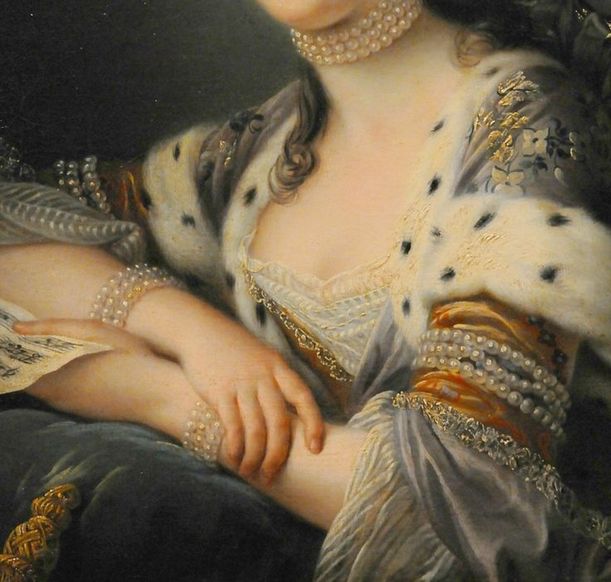 Portrait of a woman in Turkish costume. My head is so filled with everything that happened yesterday that I have to let it out! I was invited to dine with the Grand Vizier’s lady; no Christian has ever been invited for such an event. I decided that I wouldn’t satisfy her curiosity (which I bet was the point of her invitation) if I wore a traditional Turkish dress; so instead, I dressed like the women in the court of Vienna do. I went in a Turkish coach and was attended only by the woman who held my train and the Greek lady who was my interpreter. I was met by a black eunuch who helped me out of the coach and led me through several rooms where the slaves were sitting. They were dressed really nice too.
The lady was sitting on a sofa in a sable vest. She walked over to meet me, and introduced me to a dozen of her friends. She seemed really sweet and looks about fifty years old. I was so surprised to see that there’s really nothing grand in her house. The furniture was pretty modest and aside from the number of slaves she has, nothing about her seemed expensive. She totally knew what I was thinking because she told me that she no longer cares to spend her time or money on materialistic things, and that she's just concerned with charity and praying to God.
She was really hospitable and we talked until dinner was ready. Dinner was served one dish at a time. They use really rich spices in their food and the soup is served last. I felt bad that I couldn’t eat as much as the Lady wanted me to; she was so eager to serve me all kinds of food. At last, they served coffee and perfume, which is basically a sign of respect. The slaves kneeled and sprayed perfume in my hair, clothes, and handkerchief. After this, the Lady made her slaves play instruments and dance. Soon after, we left.
But the night wasn’t over yet. We visited the Kahya’s lady. I’m so glad to have gone there because it was such a difference from the Grand Vizier’s home. Lady Fatima, the Kahya’s lady, was sitting on a sofa covered with pretty Persian carpets and leaning on cushions of white satin. Two young and pretty girls covered in jewels sat at her feet. But they were hardly noticeable in comparison to fair Fatima. I have never seen anything so ridiculously beautiful and no face could ever draw attention like hers. She stood up to say hello and put her hand to hear heart with such sweetness. Although my interpreter told me Lady Fatima is beautiful, I was so amazed by her beauty that I was speechless for a few moments. Oh my God, her features! Her charm! Her perfectly proportional body! Her complexion! Her smile! Her eyes, so large and black and soft! Every angle of her face is beautiful.
After I caught my breath, I tried to find some kind of flaw in her; after examining her for a little bit, I found nothing. Nature had made her more beautiful than what Apelles could have ever painted. The most beautiful English woman would vanish near her.
Lady Fatima was wearing a caftan of gold brocade flowered with silver. The caftan was fitted and accentuated just the right parts. Her arms were decorated with bracelets of diamonds and her belt was set with diamonds too. On her head she wore a pink and silver Turkish handkerchief and her black hair was divided into many tresses. On the side of her head she was wearing a bunch of gorgeous jewels. I think you’re going to assume I am exaggerating her description. I read somewhere that women speak in rapture when they discuss beauty, but I don’t understand why they shouldn’t be allowed to do so. I’m not ashamed to say that I looked at the gorgeous Fatima with such pleasure that the finest sculpture couldn’t have given me.
Her maids sat beneath the sofa and I couldn’t help but imagine a picture of the ancient nymphs. I didn’t think such a beautiful scene ever existed. Lady Fatima ordered them to play and dance. I’m sure that the biggest prude on earth would have looked upon them and thought things I shouldn’t say. When the dance was over, four slaves came into the room and sprayed the air with perfume. Then they served us coffee in the prettiest china. Lady Fatima was so sweet; she called me Uzelle Sultanam, or the beautiful sultana, and felt bad that she couldn’t talk to me in English.
When I left, she gave me a basket of embroidered handkerchiefs. I swear I felt like I was in Mahomet’s paradise. I don’t know how all of this sounds to you but I hope you’re as excited as I am!
I plan on telling you all kinds of new stuff about this place! What will surprise you most is the way I look though…being in my Turkish clothing and all. I’ll attach a photo of myself! The first part of my dress is a pair of drawers that reach to my shoes and conceal my legs more modestly than your petticoats. They are a rosy color, brocaded with silver flowers. My shoes are white and embroidered with gold. Over this hangs my white silk gauze, edged with embroidery. The smock has wide sleeves that hang down my arm and is closed at my neck with a diamond button, but the shape and color of the bosom can be distinguished through it! The antery is a white and gold fitted waistcoat with very long sleeves falling back and fringed with deep gold fringe and have either diamond or pearl buttons. My caftan is also fitted to my body and reaches my feet, with very long sleeves. Over all of this is the belt, about four fingers wide, which is entirely made of diamonds and other gorgeous stones. Now depending on the weather, the curdee is a loose robe they throw on, made of a rich brocade (mine is green and gold) and lined with ermine or sables. The sleeves just barely reach below the shoulders.
The headdress is composed of a cap called talpock, which is made of fine velvet with pearls or diamonds in the winter, and of a light shinning silver stuff in the summer. The talpock is fixed on either side of the head that hangs a little ways down with a tassel that’s bound with a circle of diamonds or a richly embroidered handkerchief. On the other side of the head, the hair is laid flat and depending on individual taste, some ladies put flowers, feathers, or whatever they want; usually though, the ladies wear a large bouquet of jewels made to look like flowers, i.e. pearls, roses of different colored rubies, the jessamines of diamonds, jonquils or topazes, etc. Their hair hangs at its full length behind, divided into many tresses and braided with lots of pearls or ribbons!
It would be so surprising to find a woman who isn’t beautiful around here. They have the prettiest complexions in the world and generally large black eyes. The court of England does not have as many beauties as there are here. Generally, the ladies shape their eyebrows, and wear a lot of eyeliner so that at a distance, it adds very much to the blackness of them. They also paint their nails a rose-color, which I personally don’t like.
Now that I am a little more familiar with the customs in Turkey, I cannot but think of how extremely stupidity of all the writers were that gave accounts of the Turkish women. It’s so clear that these women have more liberty than we do. No woman, regardless of her rank, leaves the house without two muslins, one that covers her face but reveals her eyes, and another that hides her head and hangs half way down her back. They also cover their body shapes with a thing they call ferigee, which no woman appears without. This disguises them so that there is no way you can distinguish a great lady from her slave and no man dares to either touch or follow a woman in the street.
This masquerade allows them to do anything they want without getting discovered. So, you can imagine that not many wives are faithful in a country where they have nothing to fear from their lovers’ indiscretion. They don't have to worry about their husbands either; if they get a divorce, the rich ladies keep all of their money and property, and in addition, the husband is required to pay them. All in all, the Turkish women are the only free people in the Empire.
It’s true that the law allows men to have four wives, but a good man is not going to use that liberty and a woman of rank will definitely not tolerate it. If a man is unfaithful, he will keep his mistress in another house, just like the men in England do. Of all of the great men I know here though, only the Tefterdar keeps a few she-slaves and he has the reputation of a womanizer. Oh, and his wife lives with him but won’t see him ;)
All in all, people are not so different from one another as our travel bloggers would have us think. It would probably be more entertaining to make up some of my own customs but nothing is more pleasant than the truth.
Welcome to my first post! I'm Lady Mary Wortley Montagu and I'm so excited to share my travels with all of you! Thank you for all of your emails and tweets! I'm in Belgrade now, about to set out to Adrianople and finally really begin my travels through Turkey!
 The first half of my trip around Europe! We stayed about 6 months before we headed on to Turkey! We first arrived in Rotterdam (see pics on twitter, @Lady_Mary_WM) and then traveled to The Hague, Cologn, and Nuremburg on our way to Vienna. The culture in Vienna is wonderful! I hate to say it, but I've strayed so far from the discipline of the church as to see an opera, Angelica's Victory Over Alcina by Johann Josef Fux, at the Garden of The Favorita and I LOVED it (don't judge me, Mr. Pope)! It was so dynamic and there were so many scene changes! Check out this short recording I did at the show!
In Vienna, I had a private audience with the Empress, (Elisabeth Christine of Brunswick-Wolfenbüttel) and spent time with the ladies at court. I have to tell you about the beauty of the Empress! Forgive my poetics, but even the all the words the poets have said of Juno and Venus could not measure up to her. She has the most amazing smile, fine hair, and perfect grace: even The Venus de' Medici was not more perfectly formed. Anyway, while I was visiting, I saw many ladies of the court and I have to say that fashion in Vienna is much different than England and France and much less practical. Women's hairstyles are a bit odd too. They build up their hair so high on their heads using piles of gauze and ribbon and cover it in powder and jewels to hide it. It seems far outside the realm of common sense, but even the Empress, as lovely as she is, must comply!
The only thing that's similar to our fashion in England is the petticoat, and that has ours outnumbered by a few yards . Sometimes the women just wear a scarf with anything they like underneath. Whenever the ladies feel like getting dressed up, they declare it Days of Gala and everyone comes over in their best outfits. They wear clothes embroidered in rich gold--but they don't seem to show much taste to them provided they are expensive! 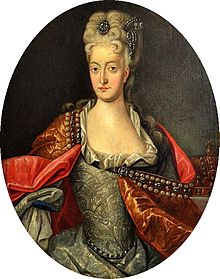 Portrait of Elisabeth Christine of Brunswick-Wolfenbüttel by Johann Gottfried Auerbach (1697–1753) One thing I do love about Vienna is the way the "older" women are treated. Here, a women of 35 is considered a young girl and is treated as young a beautiful! What a relief this would be to many young women in England who are already considered old maids; if only they had been born here instead! In Vienna, I was also encouraged to take a lover, though none of the women are coquettes or prudes. Here it seems that women are respected more based on the rank of their lovers than their husbands. It is quite common knowledge, even an expectation, that a women will take a lover; the ladies here couldn't understand why I would disgrace myself by not having a little intrigue. The women even control their lovers' estate and fortune. A young count even asked me to engage in a little affair of the heart! Obviously I said no, and had this happened in England, I would have been more offended but I spent enough time in Vienna to know that he was simply doing what he was obligated to do. "Gallantry and good breeding are as different in different climates as morality and religion" (66).
Marriage laws in Vienna are quite different from England, not that I know much about these things. Here it seems that dowries are limited to about 2,000 florins (about 200) and whatever money a woman possesses outside of the dowry is hers; her husband can't seize it or control what she does with it. As a result, many women end up wealthier than their husbands! But unfortunately, widows have no place in Vienna as they lose their rank when their husbands die.
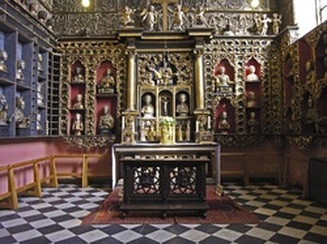 Basilica of St. Ursula's I know that you all expect to hear about the churches and convents. In Cologne, we toured the Basilica of St. Usrula's and it was beautifully decorated with rich images of saints, relics, and tons of pearls, diamonds, and rubies. I have to admit, I even found myself looking quite longingly at St. Ursula's pearl necklace…
In Vienna, I visited the convents, and St. Lawerence's was easily my favorite because of its ease and neatness. It seems much easier to live with than the nastiness and perpetual state of penance at the other convents. I couldn't help but laugh when they showed me a wooden head of our Savior that they swore spoke during the siege of Vienna (they said the open mouth was proof!). Here's a short video of the Chamber of the Bones in St. Ursula's, alleged to contain
the bones of martyred Princess and the 11,000 virgins who were massacred by the Huns (51). After all of this time in Vienna, we spent some time in Prague and Hanover, stopping at Leipzig and Brunswick in between. On the road to Leipzig I swear we almost died, the roads were so dangerous along the River Elbe. Mr. W slept through it all and I, being a good wife, didn't wake him. We barely stopped in Dresden, though I wish we could have stayed longer. The Saxon ladies as so affected, they would think it a mortal sin if they spoke or moved in a natural way.
In Hanover, the women are absolutely beautiful with rosy cheeks, snowy complexions, and coal black hair. The opera house too is much finer than the one in Vienna. We saw the Herrenhausen Gardens which were covered in snow, but still beautiful! There were so many orange trees! A brief video of the gardens We traveled back to Vienna and attended a carnival. Because of the war with the Turks, we weren't allowed to wear the typical carnival masks. We eventually left Vienna and arrived in Gyor, Hungary. For a long time, Gyor was the frontier between the Turkish and German empires. The Turks tried to conquer it many times, sometime successfully, but in the end, the Germans regained control. We continued our travels through beautiful and fruitful plains between Nosmuhl and Buda, but most of the region remains like a desert because of the long war with the Turks and the Emperor. Even worse were the towns of Adam and Fodowar, which are largely forest-like; this part of the country was better off when the Turks ruled. Because it's so little frequented, it was surprising to see the vast number of wild fowl, "which often live here to a good old age and undisturbed by Guns in quiet Sleep."
 The second half of my journey to Turkey! We took our time and traveled cross-country from Vienna to Belgrade, and soon I'll be in Adrianople! We then passed through Mohatch, Danube, Esseek, and finally Bocowar where we waited until everything was clear concerning our crossing into the Turkish frontier. We were promised by General Bassa Seraskier to be well received in Turkey! We were told that we would be escorted by a Turkish convoy in Betsko, a village between Peterwaradin and Belgrade. When we finally arrived in Betsko, we were met by Turkish soldiers and then made our way to Belgrade. Belgrade is a strong city conquered by the Grand Vizier and strengthened by the numerous garrisons of the bravest soldiers who are commanded by the Bassa. Franky, I did not feel very comfortable here. We were expecting to leave in one night but the Bassa had detained us until he received orders from Adrianople.
Fortunately, we stayed in one of the best houses here and I made friends with our host, Achmet-Beg, whose father was a great Bassa. He dined with us every night and drank wine freely. He was so happy with the liberty of conversing with me; he explained to me some pieces of Arabian poetry, which are generally written in alternate verse, and are rather musical. Their expressions of love were so passionate and lively, and I noticed they were not so different from our own English poetry! I impressed Achmet-Beg by retelling some of the Persian tales that I know. He has such wit and is much more polite than many of our own Christian men back home.
However, these amusements did not hinder me from wanting to leave this place. I'll be leaving Belgrade for Turkey tomorrow. Make sure to follow me here on the blog and my on Twitter @Lady_Mary_WM to stay updated on my adventures in Turkey! *This post references letter 1-25 of The Turkish Embassy Letters, see the full-text here*
|

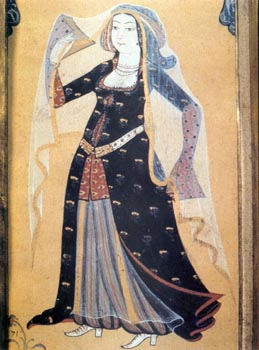
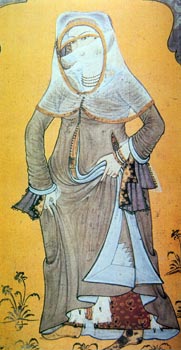
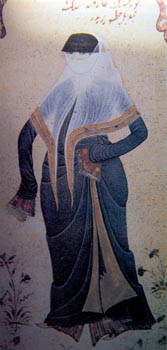






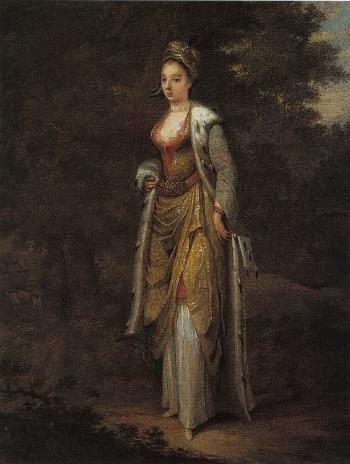




 RSS Feed
RSS Feed